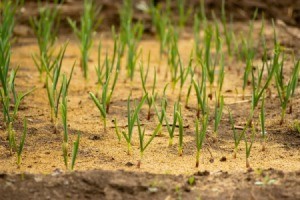Does Using Sawdust In Your Garden Take Nitrogen Away
Using Sawdust in Your Garden
Article: Nine Ways To Use Sawdust In Your Garden

EllenB
Gold Post Medal for All Time! 858 Posts
April 21, 2011
 Sawdust is inexpensive, readily available, and has many practical uses in the garden. It often gets a bad rap for "stealing" nitrogen from growing plants, but when used properly it can actually support the growth of your plants by helping to improve your soil. Sawdust can also be used to store crops, repel pests, deter weeds, and is handy for cleaning up accidental spills.
Sawdust is inexpensive, readily available, and has many practical uses in the garden. It often gets a bad rap for "stealing" nitrogen from growing plants, but when used properly it can actually support the growth of your plants by helping to improve your soil. Sawdust can also be used to store crops, repel pests, deter weeds, and is handy for cleaning up accidental spills.
- Amend Your Soil: Add small amounts of sawdust to your soil to increase organic matter and improve its texture. Because sawdust is very slow to decompose, it works especially well in moist, heavy soils like clay, where soil amendments tend to break down quickly.
- Compost It: For composting purposes, sawdust is considered a "brown" (carbon) material, which can be added in alternating layers to balance out the "green" (nitrogen) materials like grass clipping and food scraps. Sawdust also acts as a bulking agent, allowing air into the pile. It takes approximately a year to transform raw sawdust into finished compost.
- Discourage Weeds: Not many gardeners know this, but sawdust (especially from hardwoods like walnut trees) is a natural weed killer. Sweep it between the cracks and crevices of concrete sidewalks and in between stepping stones to help prevent weeds from popping through.
- Grow Mushrooms: If you have ever considered growing your own mushrooms, sawdust can make a good growing medium. Unlike green garden plants, mushrooms lack chlorophyll and rely on other organic materials for their food. In nature, logs work well for this. In the garden, you can use a mixture of sawdust and woodchips. Growing mushrooms successfully requires monitoring temperature and light. For information and supplies, check out: http://www.mushroompeople.com
- Mulch With It: Sawdust has an acidifying effect on the soil, and is a good choice for mulching around acid-loving plants like conifers, blueberries, strawberries and rhododendrons. Keep in mind that fresh, non-composted sawdust will hog nitrogen as it decomposes, so using too much of it without adding supplemental fertilizer to the soil can cause a nitrogen deficiency in your plants.
- Pave a Path: Sawdust is the ideal material for creating an inexpensive garden path. It's soft, looks natural, helps control erosion, and it smells really great! Start by marking out your path. Clear away existing grass and weeds to expose the soil. Apply a thick layer of sawdust and tamp it firmly into place. Walked-on sawdust compacts quickly, so expect to refresh your path every few years.
- Repel Slugs: Sawdust (especially coarser sawdust) can help keep slugs at bay. Raise the foliage around susceptible plants and apply several inches around the base of stems.
- Soak Up Spills: Sawdust is highly absorbent, which great for cleaning up occasional drips and leaks from lawn and garden equipment. Keep a bucket handy in your garage or garden shed. Toss a handful of sawdust over the spillage, wait for it to be absorbed, then sweep it up cleanly with a broom.
- Store Root Crops: Root vegetables like carrots, beets, and turnips can be placed in a single layer and kept over the winter in a box filled with fresh sawdust. To maximize their shelf-life, store the box in a cool place like a semi-heated garage or unheated basement at approximately 35-40 degrees F.
Warning: Sawdust Can Rob Soil of Nitrogen
Using sawdust in the garden is not without its problems. Like other wood products, as sawdust breaks down and decays it locks up important nutrients in the soil - namely nitrogen. Spreading raw or "green" sawdust in the garden can lead to a nitrogen deficiency resulting in the malnutrition of your plants. Fortunately, there are a couple of ways around this:
- Let the sawdust simmer in the compost pile for at least a year before using it in the garden.
- When using raw or "green" sawdust, provide regular applications of a slow-release organic fertilizer to counteract any nitrogen deficiencies.
- Avoid using large quantities of sawdust around plants at one time. Start with small amounts and see how your plants react.
If your soil is low in organic nutrients to being with, pay extra attention to your plants during the growing season. If they start to appear light yellow in color, they may be suffering from nitrogen deficiency. You can counteract this by side-dressing them with an organic fertilizer such as alfalfa meal or blood meal, compost, or manure.
Sourcing Sawdust
The best sawdust for garden use has a slightly course texture - the type created as a byproduct of sawmills or chain saws. Very fine sawdust, like the dust created from sanding furniture or cabinets, has a tendency to become packed down and anaerobic so it's not a good choice. Also, make sure you know what type of wood was used to create the sawdust.
Walnut, cedar, and chemically treated wood should never be used on garden plants, but may be suitable for soaking up spills or creating garden paths. To source sawdust in your area, check with local lumberyards and tree removal companies. Many will offer sawdust for free (or at least very inexpensively), especially if you're willing to pick it up and haul it home yourself.
Questions
Ask a QuestionHere are the questions asked by community members. Read on to see the answers provided by the ThriftyFun community or ask a new question.
Question: Composting Pine Sawdust?

June 1, 2018
Is pine sawdust/shavings good for making compost? I have chickens so nitrogen is not a problem.
Thanks.
Answers

Pghgirl40
Bronze Feedback Medal for All Time! 196 Feedbacks
June 1, 2018 0 found this helpful
Best Answer
If you are doing this, my only suggestion is be sure the wood isn't treated with chemicals..
Meaning if it is from your own trees, and you cut them down and got them into this format and you know that they were not treated repeatedly with chemicals or pesticides you should be OK.
But, if you got the lumber from a store and were making something with it and that is how you got the shavings/dust, double check with the store to make sure it wasn't treated wood or if it was what it was treated with...then research that chemical.
I am always nervous about chemicals leaching into my soil.

jeanmurray01
Bronze Answer Medal for All Time! 111 Answers
June 3, 2018 0 found this helpful
Best Answer
Yes you can compost pine sawdust. it is considered a brown addition. You can also consider making some pine sachets to put in your closet or dresser drawers, or shoes. Make them fancy by sewing with pretty fabric, or make them fast and functional by stuffing old socks with the sawdust. Have fun.
Question: Adding Pine and Cedar Stump Grindings to a Flower Bed?

March 17, 2017
Have I made a major mistake in my flower bed? I just backfilled some holes in my flower bed with the sawdust and dirt from some ground up stumps from pine trees. The oldest of the stumps may have been five or 10 years old. The newest just three weeks old. I didn't think about the effect that the sawdust would have on the soil until I was about finished with the last hole which happened to be from a small cedar tree stump from about two years.
At this point, I panicked and I decided to get some information on what effect this may have on the flower bed and any future plants. I had been piling grounded up leaves in this bed, so I have mixed them in also. I read you article about using sawdust in the garden. I am not feeling great about what I have done to my flower bed. Will I have to wait a year to plant? Will cow manure help?
Answers

March 17, 2017 0 found this helpful
Cedar is a type of pine. You should be ok.

Judy
Gold Post Medal for All Time! 677 Posts
March 18, 2017 0 found this helpful
As long as the bed is not next to the foundation of the house you are ok. You don't want termites.

cybergrannie
Gold Feedback Medal for All Time! 949 Feedbacks
March 19, 2017 1 found this helpful
I'm not sure anyone is really addressing the question you asked.
Most true gardeners will say not to mix more than a very small amount of sawdust in your flower/garden bed as it is slow to breakdown and robs nitrogen from your soil. Maybe the fact that most of the stumps were 10 years old may shorten the breakdown period but that is questionable. A small amount of cedar may not be a problem but still - there is still a breakdown period.
You may be able to add nitrogenous fertilizer and it may help it break down faster and give back to the soil some nitrogen. Then again, you may have to wait a year to plant your flowers.
I believe you should call or visit your agriculture agency and tell them what you have done and ask them for help. Google agriculture agency and your zip code for information. You may be able to get your soil tested and get recommendations on how to save your flower bed.
Reply Was this helpful? 1

May 14, 2017 0 found this helpful
Cedar isn't a type of pine. Trying to learn about the relationships among plants by using common names is confusing. There are several trees called cedar that aren't closely related. If you're interested in the fascinating topic of botanical classification, you might audit a course at your local university or learn from a local botanical or native plant society.
Question: Using Sawdust as Base for a Stone Walkway?

April 14, 2019
I had 3 stumps ground down which left a lot of sawdust in the side of my house. My plan was to make a stone walkway and I do not want to grow grass or plant anything.
Can I leave the sawdust as a base and put decorative stone and pavers on top of the sawdust?
Answers

Pghgirl40
Bronze Feedback Medal for All Time! 196 Feedbacks
April 14, 2019 0 found this helpful
You can, but here is what I was told when I asked that same question of a home inspector. DO NOT DO IT!
Why, I asked?
Because they can attract carpenter ants and termites was what he told me. Pittsburgh has issues with both of these, so you may not have these challenges and it will be OK.
He said to keep all branches, saw dust, get rid of stumps, etc.
I should knock very loudly on wood that we did as told and have not had termites or carpenter ants. Regular ants, yes, but those we have figured out how to prevent.
Best wishes!!

Judy
Gold Post Medal for All Time! 677 Posts
April 14, 2019 0 found this helpful
Sawdust will attract termites. This is not a good idea.
Using Sawdust to Deter Slugs
Slugs can easily eat lots of you plant leaves. There are many types of slug deterrents, sawdust is one all natural option. This is a page about sawdust to deter slugs.

Published by ThriftyFun.
Desktop Page | View Mobile
Disclaimer | Privacy Policy | Contact Us
Generated 2021-12-02 09:06:25 in 6 secs. ⛅️️
© 1997-2021 by Cumuli, Inc. All Rights Reserved.
https://www.thriftyfun.com/Using-Sawdust-in-Your-Garden.html
Does Using Sawdust In Your Garden Take Nitrogen Away
Source: https://www.thriftyfun.com/Using-Sawdust-in-Your-Garden.html
Posted by: adornofreeack.blogspot.com

0 Response to "Does Using Sawdust In Your Garden Take Nitrogen Away"
Post a Comment